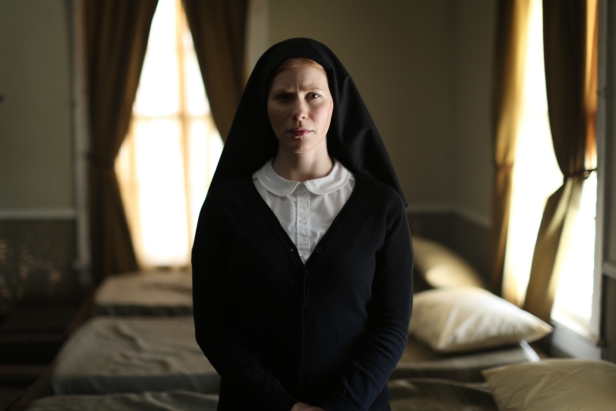With Aislinn Clarke’s The Devil’s Doorway, Paul Hyett’s Heretiks and Corin Hardy’s The Nun all enjoying their premières in rapid succession, 2018 would appear to be the year that sees nunsploitation returning with a vengeance. Not that St Agatha, the latest from genre director Darren Lynn Bousman (Abattoir, Repo! The Genetic Opera, the first three Saw sequels), is set in the present day. For if nunsploitation seems something of a throwback to cinema of older times (chiefly, the 1970s), then St Agatha‘s events unfold even longer ago, in 1957, when the women’s liberation movement was still a decade or so in the future.
The film opens with a scene – a flashforward, in fact – that is all at once a trope familiar from horror, and a metaphor for the heroine’s constant status in her frantic quest for freedom. “Get me out!”, Mary (Sabrina Kern) screams from inside a coffin, banging in vain on its sealed metal lead – and although the precise circumstances that have led Mary to this nightmarish confinement will only gradually be revealed through a series of flashbacks, in a sense Mary was already trapped long before she arrived at the remote convent that will become her prison. She was trapped in the closed patriarchy represented by the iron fist with which her punch-drunk father ruled his (and her) house, trapped by guilt for the small part she played in the accidental death of her young brother William (Maximus Murrah) before she could escape their father with him, and trapped by the baby she is carrying in her belly while her musician boyfriend Jimmy (Justin Miles) is out on the road and she had been left alone and penniless. In a soup kitchen, Mary accepts a card from a nun, and heads out to the ‘Sisters of Divinity’ Convent seeking several different kinds of deliverance: not just the spiritual expiation of her sins (for being a ‘fallen woman’, an unmarried fornicator, and a grifter), but also her salvation from impossibly constraining circumstances of poverty and abandonment, as well, of course, as the safe delivery of her baby.
The sort of refuge that Mary finds at the convent is altogether more sinister. For the Mother Superior (the brilliantly menacing Carolyn Hennesy) treats the place – and the pregnant women who have ended up there – as a business, and will let nothing and nobody get in the way of her profit. Drugged, traumatised, tortured, brainwashed and ‘gaslighted’ (a now fashionable term that Mary, always ahead of her time, employs a good decade before it came into popular usage), our heroine struggles to find a way out of this hell, and to become a single mother on her own terms, free from the demands placed by others on both herself and her baby. This being a genre film, Mary’s struggle for liberation is presented in the language of gothic. Cinematographer Joseph White bathes everything in hallucinatory stained-glass colours, Mark Sayfritz’s score is a Suspiria-like symphony of spooky susurrations and demonic psalms, while Molly Coffee’s production design transforms the hideously wallpapered convent building into an oppressive jailhouse filled with sadistic sisters, strange masked figures, and hidden secrets.
In the end, though, this is the story of a young woman trying to break free from societal repression and institutional abuse – which makes it, despite the Fifties setting, feel very fresh in the #MeToo age. To achieve her sainthood, and to become the ‘good woman’ that the name Agatha means in Greek, Mary must endure visions and sufferings until she transcends her pain, strikes out for her own independence and becomes a superior mother herself – or else until this sisterhood, perverted against itself, either inducts or silences her forever.
St Agatha was seen and reviewed at Arrow Video FrightFest 2018.
